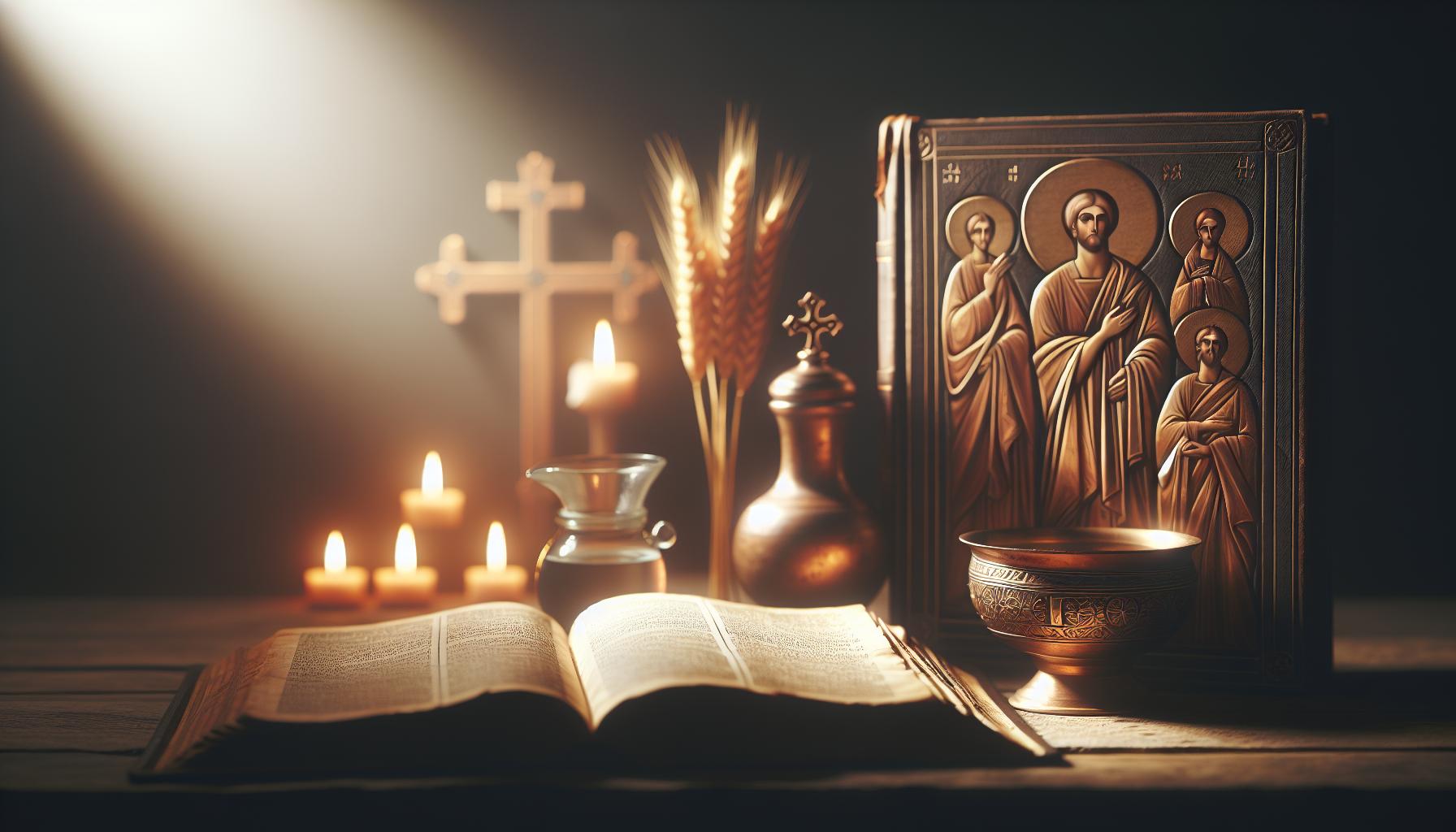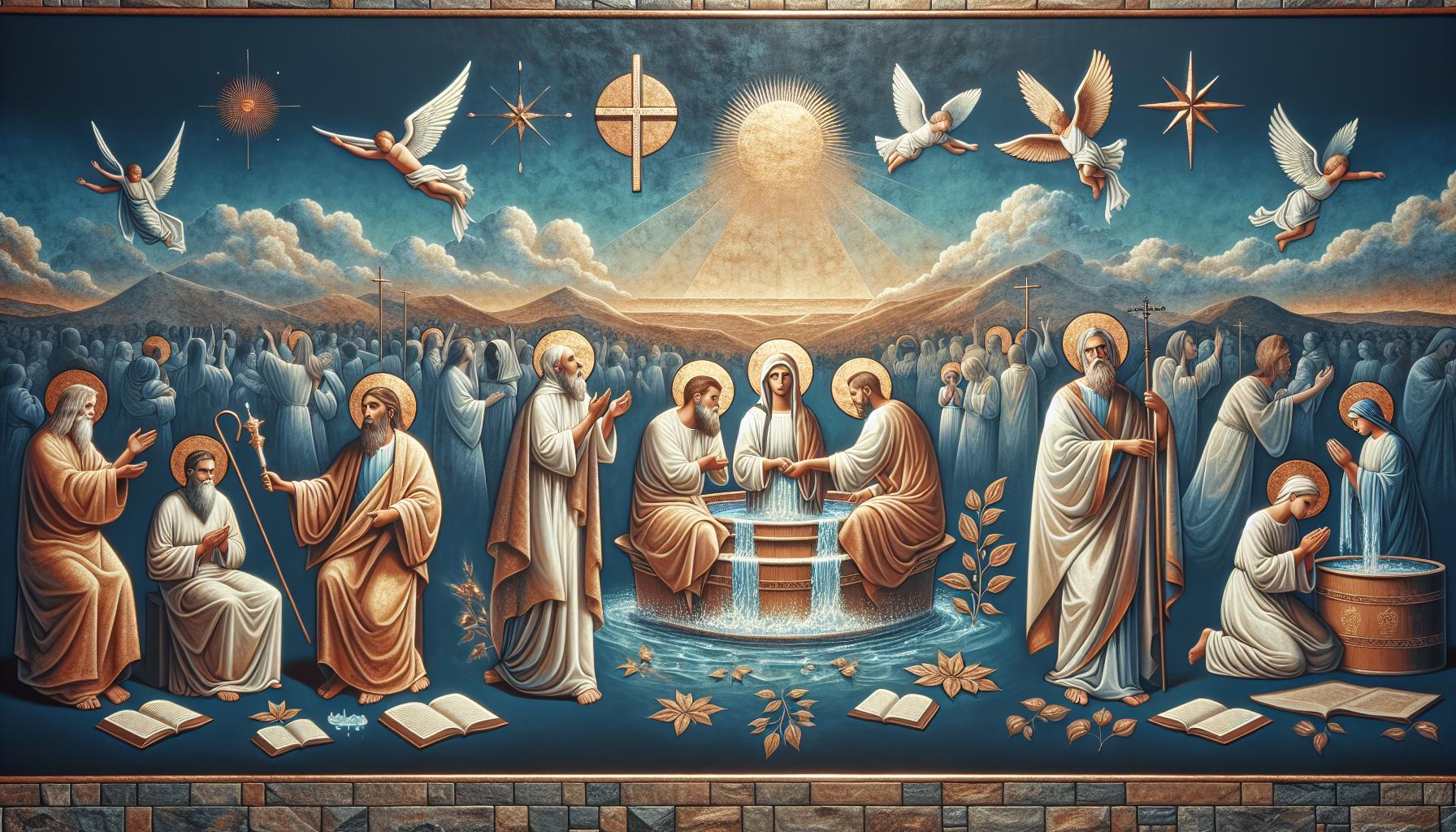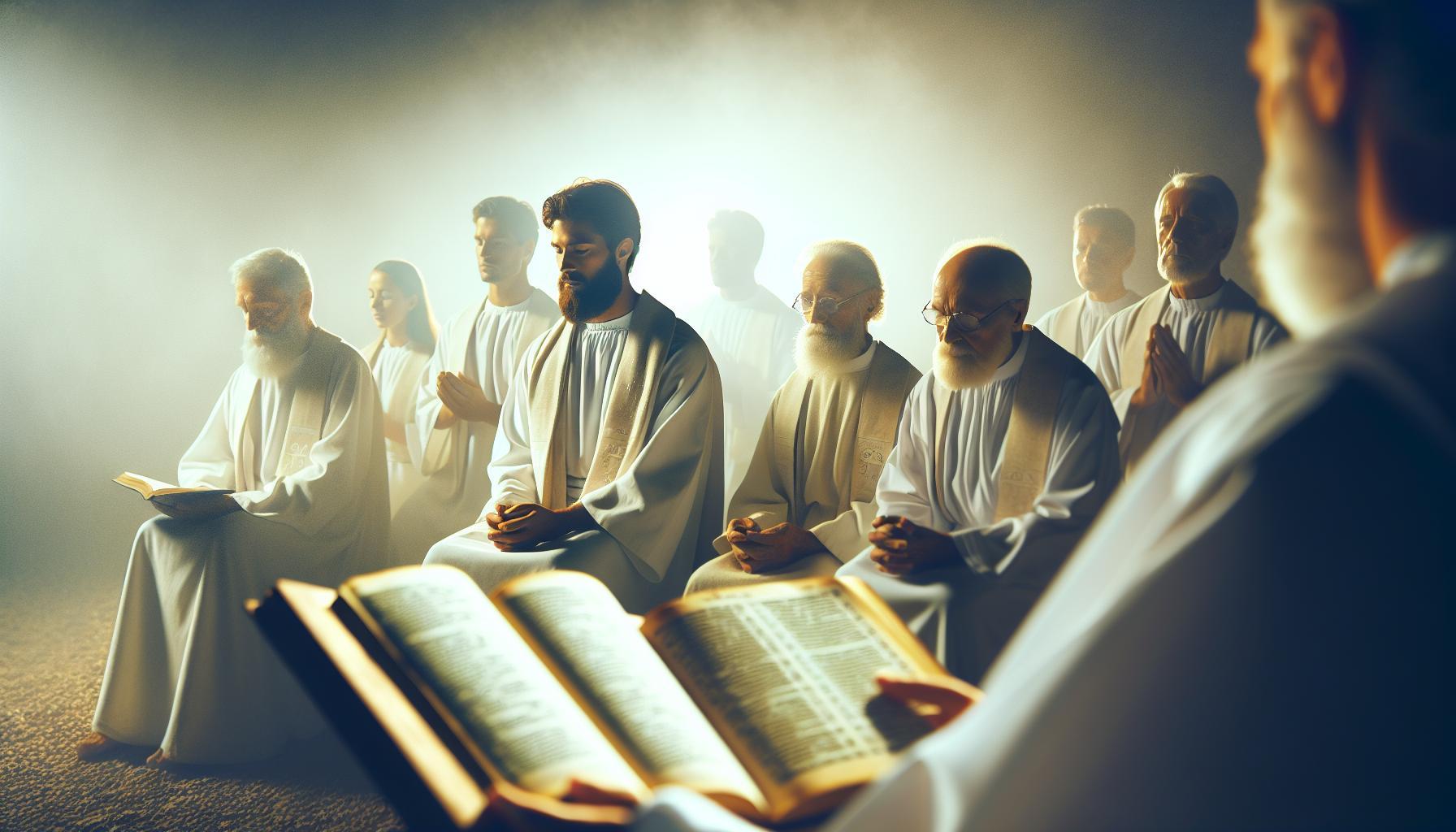What is the true origin of baptism, one of the most significant rituals in Christianity? Understanding its historical and scriptural roots sheds light on its profound meaning today. This exploration not only enriches our knowledge of Christian traditions but also deepens our appreciation for the transformative power of faith and community.
The Roots of Baptism: Tracing Ancient Practices and Rituals

The rich tapestry of baptismal traditions we find today can be traced back through a myriad of ancient practices and rituals that illustrate humanity’s deep connection to water as a symbol of purification and rebirth. From the sacred rites of the Israelites to the transformative teachings of early Christians, understanding how baptism began offers a fascinating glimpse into spiritual evolution. This exploration illuminates not only the origins of the practice but also its enduring significance across cultures and epochs.
Jewish Influence on Early Practices
The roots of baptism are heavily influenced by Jewish purification rituals known as *mikvah*. These rituals involved immersing oneself in a body of water, a practice that was both a spiritual cleansing and a means of preparing for significant events, including entry into the Temple or participation in festivals. The act was seen as essential for purification from sin and impurities, establishing a foundational spiritual significance that would inform later Christian practices.
- Mikvah: Ritual purification by immersion in water.
- Symbolism of Water: Seen as a means of renewal and cleansing.
- Redemption and Forgiveness: Suggested a path to spiritual restoration.
John the Baptist: A Pioneering Figure
The ministry of John the Baptist marked a significant evolution in the practice. According to the Gospels, John preached a baptism of repentance for the forgiveness of sins, using water as a symbol of spiritual renewal and a call to moral awakening. This baptism was not only an act of personal repentance but also a communal invitation to a new covenant—a theme that would resonate deeply in the teachings of Jesus.
| Aspects of John’s Baptism | Significance |
|---|---|
| Repentance | Encouraged individuals to reflect on their lives and seek forgiveness. |
| Water Symbolism | Represented cleansing of the spirit and preparation for a new way of life. |
| Community Engagement | Gathered crowds, fostering a sense of collective spirituality and renewal. |
The Transformation within Christianity
Following the resurrection of Jesus, baptism was redefined as a rite of passage into the Christian faith. The New Testament describes baptism performed in the name of the Father, the Son, and the Holy Spirit, a practice that highlights its centrality to Christian identity and community. As teachings spread throughout the Roman Empire, the ritual adapted to various cultural contexts, embedding itself as a vital sacrament in Christian life.
The early Church recognized baptism not only as a physical act but as a spiritual transformation—an outward demonstration of an inward change. Early converts were often baptized immediately upon declaring their faith, signifying a profound commitment to a new life in Christ.
This understanding of baptism serves as a cornerstone for many denominations today, illustrating how the practice has evolved while maintaining deep spiritual roots. The historical and scriptural origins of baptism reveal a journey marked by both continuity and transformation, reminding believers of the significance of this sacred ritual in their lives.
Biblical Foundations: An Exploration of Water and Spirituality
Water has been a vital element in human spirituality for centuries, carrying deep symbolic meaning across various cultures and religions. In Christianity, its significance is profoundly illustrated through the practice of baptism, an act that signifies spiritual cleansing, renewal, and the initiation into a community of faith. Exploring the biblical foundations of water within a spiritual context unveils not only its historical roots but also its transformative power in the lives of believers.
Water as a Symbol in Scripture
Throughout the Bible, water emerges as a powerful symbol entwined with themes of life, purity, and divine presence. Significant biblical waters include:
- The Creation Narrative: Water is present from the very beginning, as seen in Genesis 1:2, where the Spirit of God hovers over the waters, indicating God’s control over chaos and His creation process.
- The Great Flood: In Genesis 6-9, water becomes a means of judgment and renewal, cleansing the earth and allowing for the new beginnings embodied by Noah and his family.
- Living Water: In the New Testament, Jesus refers to Himself as the source of “living water” (John 4:10). This metaphor emphasizes spiritual sustenance and eternal life.
These instances establish a foundational understanding of water as a conduit for divine interaction and revelation, setting the stage for the ritual of baptism.
The Connection Between Baptism and Spiritual Renewal
The practice of baptism, deeply rooted in Jewish tradition, acts as a bridge between the Old and New Testaments. It signifies a believer’s transition from a life of sin to one of righteousness. The act of immersion in water not only symbolizes cleansing but also mirrors the death and resurrection of Jesus Christ. Romans 6:4 articulates this beautifully: “We were therefore buried with him through baptism into death in order that, just as Christ was raised from the dead through the glory of the Father, we too may live a new life.”
In this way, baptism showcases both a communal and personal aspect of faith. It invites individuals to participate in a ritual that connects them to the global church while simultaneously marking a personal commitment to follow Christ. The early church embraced this understanding, leading to the practice being codified as an essential rite of initiation.
An Invitation to Explore Your Spiritual Journey
For those looking to deepen their understanding of baptism and its spiritual implications, consider taking the following actionable steps:
- Study Scripture: Dive into passages related to water and baptism, such as Matthew 3:13-17, where Jesus Himself is baptized, and Acts 2:38, which underscores the transformative call to repentance.
- Join a Community: Engage with a local church or a Bible study group where discussions about baptism and its significance can deepen your understanding.
- Reflect: Take time to meditate on your own spiritual journey and the role that baptism may play within it. What does it mean for you to be spiritually renewed?
By engaging with these practices, one can explore the rich tapestry of water and spirituality that runs through biblical history, ultimately answering the question of how baptism began and its enduring significance in the Christian faith.
| Key Biblical Events Related to Water | Significance |
|---|---|
| Creation | Symbolizes God’s authority and the potential for new beginnings. |
| The Flood | Represents judgment and the opportunity for spiritual renewal. |
| Baptism of Jesus | Affirms Jesus’ identity and sets a precedent for the practice of baptism. |
As we engage with these themes, we recognize that baptism is not merely a ritual but a profound expression of faith that links physical water with spiritual life. By understanding the biblical foundations of water and its symbolism, believers can appreciate the depth of baptism as both a historical practice and a personal journey in their spiritual walk.
The Role of John the Baptist: Paving the Way for a New Era

John the Baptist stands as a pivotal figure in the transition from the old covenant to the new, embodying the profound shift that was to shape religious thought and practice in the coming era. His role as the forerunner to Jesus Christ was foretold in the Scriptures, particularly in the prophecies of Isaiah and Malachi, highlighting his divinely appointed task of preparing the hearts of the people for the arrival of the Messiah. Through his message of repentance and his practice of baptism, he introduced a transformative method of spiritual cleansing that redefined the relationship between faith and ritual.
The Call to Repentance
Central to John the Baptist’s mission was his call for the Jewish people to repent. This call was not merely for a change of heart but was an urgent invitation to undergo a complete transformation in their lives. By urging individuals to acknowledge their sins and seek God’s forgiveness, John emphasized that genuine repentance was essential for spiritual renewal. His baptisms symbolized this inward dedication, serving as an outward expression of a commitment to a new way of living in alignment with God’s will. Those who responded to John’s call were publicly immersed in water, which served as a powerful ritual of purification, preparing them for a deeper relationship with God through the coming Christ [[1]](https://www.gotquestions.org/baptism-of-John.html).
A New Era of Faith
John the Baptist’s actions paved the way for a radical change in religious practice. By introducing baptism as a standard for repentance, he shifted the focus from purely ceremonial law adherence to a more heartfelt, personal engagement with faith. This emphasis on inner transformation over external observance was revolutionary and marked the beginning of a new era within Jewish spirituality. John proclaimed that the Kingdom of God was near, inviting people to prepare their lives for an imminent shift in their spiritual destiny through an authentic connection with God [[2]](https://www.gotquestions.org/prepare-the-way-of-the-Lord.html).
This preparation was crucial, as it set the context for Jesus’s ministry. John recognized that his role was not only to guide individuals toward repentance but also to point them toward the Messiah who would ultimately fulfill God’s promises to His people. By baptizing Jesus, John affirmed his role as the herald of a new covenant, where grace would replace the law, and faith would become the cornerstone of the believer’s experience. This transition invites believers today to reflect on their own journeys of faith, considering how the themes of repentance and renewal are still relevant in their spiritual lives. Ultimately, John the Baptist’s role illustrates the dynamic interplay between prophecy, preparation, and the transformative power of faith in paving the way for a new era.
Early Christian Communities: Baptism as a Symbol of Belonging

The practice of baptism has deep roots in early Christian communities, serving not only as a rite of initiation but also as a profound symbol of belonging. As new believers entered these communities, baptism marked their public declaration of faith and their commitment to a life shared among fellow believers. This communal aspect of baptism was essential; it represented the transformative journey from isolation to inclusion, embodying the essence of what it meant to belong in a community centered around Christ.
In the context of early Christian teachings, baptism was significantly influenced by Jewish purification rituals, which used water as a symbol of cleansing and renewal. As believers emerged from the waters of baptism, they emerged as new creations, unified in their shared faith and values. The New Testament reflects this understanding; for example, Paul emphasizes in Galatians 3:27-28 that through baptism, believers are clothed with Christ and transcended earthly divisions—this was a radical concept at the time, highlighting the inclusivity of the Christian message.
Communal Significance of Baptism
The act of baptism within these communities was not merely personal; it was a communal affair that involved the entire faith community. This collective participation reinforced the idea that each individual, through their baptism, was not only identifying themselves with Jesus but also committing to a community that supported each other in their spiritual journeys. This was essential for the growth and stability of early Christian groups, fostering a bond that fortified their beliefs against external pressures and persecution.
- Public Declaration: Baptism served as a public testimony of faith, solidifying one’s place within the Christian community.
- Shared Experience: It created a collective identity among believers, linking them through shared beliefs and practices.
- Support Network: Newly baptized members became part of a support system, helping each other navigate their faith in a challenging world.
Ultimately, the symbolism of baptism as a rite of passage goes beyond personal faith; it encapsulates the commitment to a lifestyle characterized by mutual support and shared values. In exploring “How Did Baptism Start? Historical and Scriptural Origins Explained,” it is evident that baptism was foundational in forming early Christian communities, illustrating a powerful narrative of connection and belonging that continues to resonate within Christian practices today.
Diverse Interpretations: How Different Traditions Approach Baptism

The practice of baptism, rich in symbolism and significance, varies widely across different religious traditions, each interpreting its meaning and purpose in unique ways. Historical evidence suggests that its origins are deeply rooted in various cultures, making it a fascinating study in both theology and anthropology. To explore how diverse faiths approach this rite can enrich our understanding of its transformative power and communal relevance.
Christian Perspectives
In Christianity, baptism is primarily seen as a rite of initiation and purification. Most denominations affirm that it symbolizes a believer’s faith in Christ, representing the washing away of sin and the rebirth into new life. However, interpretations of its significance can differ:
- Catholicism: In the Roman Catholic Church, baptism is considered a sacrament necessary for salvation, often performed on infants to cleanse them of original sin.
- Protestantism: Many Protestant denominations view baptism as an outward expression of an inward faith, commonly practiced as a voluntary act of obedience upon personal belief.
- Orthodoxy: In Eastern Orthodox traditions, baptism involves a trinitarian formula and is often followed by chrismation, emphasizing both community and personal faith.
Non-Christian Interpretations
While Christianity prominently features baptism, other religious traditions also incorporate water-related rituals that share similar themes of cleansing and renewal.
- Judaism: The mikveh, or ritual bath, represents spiritual purification before significant life events, signifying a readiness to connect with the divine.
- Hinduism: Snana, or ritual bathing in holy rivers, serves as a means of cleansing sins, reflecting a belief in the transformative power of water in spiritual practice.
- Islam: Although not equivalent to baptism, the practice of wudu (ablution) serves to purify before prayers and emphasizes cleanliness as a form of spiritual readiness.
Comparative Insights
Comparing these varied interpretations reveals common threads of purification, transformation, and community connection. The table below highlights key differences and similarities among the traditions:
| Tradition | Purpose of Baptism or Equivalent | Typical Age for the Practice |
|---|---|---|
| Christianity | Initiation and forgiveness of sins | Infants or adults |
| Judaism | Spiritual purification | Any age, context-dependent |
| Hinduism | Cleansing of sins | Any age, often at pilgrimage sites |
| Islam | Purification before prayers | Any age, part of daily practice |
A deeper understanding of these diverse practices not only reveals the historical and scriptural origins of baptism but also illustrates the essential human yearning for connection, identity, and transformation found within these sacred acts. Each interpretation invites individuals to explore their beliefs, creating a rich tapestry of faith across cultures.
Theological Significance: What Baptism Means Across the Ages
Throughout history, baptism has been more than a mere ritual; it has served as a profound symbol of faith, transformation, and community. This sacred practice, rooted in both historical and scriptural traditions, reflects the spiritual journey of individuals and the theological frameworks established by varying religious contexts. From its early beginnings to its role in contemporary practice, the significance of baptism continues to evolve across the ages, shaping the beliefs and identities of countless communities.
The Roots of Baptism in Scripture
Baptism traces its origins back to biblical times, where it was first practiced as a form of purification. In the Old Testament, ritual washings and purifications were commonplace, but it was John the Baptist who redefined this act by introducing the concept of baptism as an initiation into a new way of life. According to the Gospels, Jesus Himself was baptized in the Jordan River, marking a pivotal moment that linked baptism to the themes of repentance and renewal:
- Repentance: Baptism is a public declaration of turning away from sin.
- New Life: It symbolizes the believer’s identification with Christ in His death, burial, and resurrection.
- Community Foundational: Early Christians saw baptism as a rite that united believers within the body of the Church.
This biblical foundation not only established baptism as a key sacrament in Christian faith but also set the stage for its theological significance across different denominations.
The Evolution of Meaning
As centuries passed, the understanding and practice of baptism evolved, reflecting the theological shifts within Christianity itself. In the early Church, baptism was closely associated with initiation into the Christian community, often involving lengthy catechesis and preparation. Over time, the practice diversified, leading to different interpretations and forms of baptism, such as infant baptism versus believers’ baptism. Each perspective carries theological implications:
| Type of Baptism | Theological Emphasis | Common Practices |
|---|---|---|
| Infant Baptism | God’s grace and covenant | Sprinkling or pouring of water |
| Believer’s Baptism | Personal faith and repentance | Immersion in water |
This distinction highlights the ongoing dialogue within Christian traditions about the relationship between faith, grace, and the necessity of baptism for salvation. Each tradition upholds a unique perspective that informs their theological underpinnings and community practices.
Contemporary Implications of Baptism
In today’s context, baptism serves not only as an entry point into faith but also as a reminder of personal transformation and communal identity. Many denominations emphasize its importance in spiritual formation, social justice, and outreach. For instance, baptism is often linked with a commitment to living out one’s faith through service and compassion, reflecting the call of Christ to love and minister to others.
Ultimately, understanding baptism’s theological significance throughout history sheds light on its continued relevance in modern faith practices. As communities engage with their traditions and scriptural foundations, they find renewed meaning in this time-honored ritual, making it a powerful testimony of faith not just for individuals, but for the global Church as a whole.
Modern Perspectives: Baptism in Today’s Church Practices
In contemporary Christianity, baptism represents more than just a ritual; it embodies a complex tapestry of beliefs, traditions, and practices that vary significantly across different denominations. Each community brings its interpretation of this ancient rite, shaped by historical and scriptural origins as outlined in discussions around how baptism started. Today, many churches offer baptism not just as a form of initiation into faith, but also as a significant personal milestone that connects individuals to their community and their beliefs.
Diverse Practices Across Denominations
The practice of baptism today varies widely among various Christian denominations. Here’s a look at some of the most common practices:
- Infant Baptism: Common in Catholic, Orthodox, and some Protestant churches, this practice emphasizes the grace conferred upon infants through baptism, acknowledging the belief that God’s love and mercy extend to all, irrespective of age.
- Believer’s Baptism: Predominant in Baptist and Anabaptist communities, this practice states that baptism should only be administered to those who have made a conscious decision to follow Christ, thus closely linking faith and the individual’s understanding of the scriptures.
- Conditional Baptism: Practiced when there is uncertainty about the validity of a previous baptism, this approach highlights the church’s commitment to ensuring that every individual is truly welcomed into the faith.
- Affusion and Immersion: Different practices about how the baptism is performed—whether by sprinkling water, pouring, or full immersion—demonstrate the varying interpretations of baptism’s symbolic significance.
The Role of Community and Technology
As we observe how baptism has evolved, the role of community and technological advancements is paramount. Many modern churches leverage social media and live-streaming to celebrate baptism services, allowing family and friends who cannot be present to participate virtually. This innovation not only broadens the reach of the church community but also highlights the personal nature of the event, as many churches create online platforms for individuals to share their stories and experiences leading to baptism.
Moreover, churches often provide pre-baptism classes that go beyond the historical and scriptural origins of baptism discussed in ways of how it started. These classes help potential candidates understand the significance of their commitment and provide a space for them to ask questions, connecting their personal faith journey with the broader narrative of the Christian community.
Conclusion (Optional for Context)
Through these diverse practices and the incorporation of modern technology, baptism in today’s church reflects a blend of tradition and contemporary relevance, continually inviting believers to consider their faith in light of both historical teachings and their unique spiritual journey. Each baptism is a reaffirmation of communal faith and individual choice, stemming from the rich history that began centuries ago.
Faq
How did baptism start historically?
Baptism began as a ritual of purification in ancient Jewish culture, later adopted by early Christians. It symbolizes the *initiation into the community of faith* and the washing away of sin.
The practice can be traced back to the Old Testament, where rituals required *ritual washing* for purity. John the Baptist initiated baptizing as a call for repentance before Christ, and after His resurrection, the apostles continued this practice, establishing baptism as a central sacrament in Christianity.
What is the significance of baptism in Christianity?
Baptism holds profound significance in Christianity as it symbolizes *identification with Christ* and entry into the *Christian community*. It represents a commitment to a new life in faith.
Through baptism, believers express their faith publicly, marking a transformative step in their spiritual journey. Many denominations view it as an essential sacrament that connects them to the teachings of Jesus, reflecting on *Scriptural foundations* found in the Gospels and the Acts of the Apostles.
Can I be baptized if I wasn’t baptized as a child?
Yes, anyone can be baptized regardless of age or previous religious background. *Adult baptism* is a common practice that emphasizes personal decision and commitment to faith.
Baptism is not limited to childhood; many faith traditions encourage individuals to seek baptism when they are ready to make a conscious decision to follow Christ. This allows for a deeper understanding and appreciation of the sacrament’s significance.
Why does baptism involve water?
Baptism involves water to symbolize *cleansing and rebirth*. Water represents new life and is a physical manifestation of the spiritual transformation that takes place during the ritual.
Throughout the Bible, water is associated with purification and life. In the Old Testament, it is used in ceremonies for ritual cleanliness. The New Testament reinforces this symbolism, illustrating that through water, believers are *washed clean* from their sins, as stated in passages like Acts 22:16.
What is the scriptural basis for baptism?
The scriptural basis for baptism is primarily found in the New Testament. Key verses include Matthew 28:19, where Jesus commands the disciples to baptize, and Acts 2:38, which emphasizes repentance and baptism for forgiveness.
These passages serve as foundational texts that guide the practice of baptism across various Christian denominations. They highlight the significance of baptism not only as a symbolic act but also as a necessary step toward salvation and participation in the *faith community*.
What types of baptism are recognized across denominations?
Several types of baptism are recognized, including *infant baptism*, *believer’s baptism*, and *sprinkling* or *immersion*. Each tradition interprets the practice according to its theological understanding.
For instance, *infant baptism* is common in Catholic and some Protestant churches, signifying inclusion in God’s covenant. In contrast, *believer’s baptism* is emphasized in Baptists and Evangelical circles, focusing on a personal affirmation of faith before being baptized. This variance reflects differing theological perspectives within the broader Christian tradition.
How does baptism connect to the teachings of Jesus?
Baptism is intimately connected to the teachings of Jesus as it embodies His directive to spread the Gospel and establish a community of believers. Jesus Himself was baptized and highlighted its importance.
In Matthew 3:16-17, His baptism signifies the initiation of His ministry and serves as a model for all believers. By following this example, Christians fulfill the *Great Commission* and express obedience to Christ’s teachings, fostering a community rooted in His message.
Wrapping Up
In conclusion, the origins of baptism are rich with historical significance and theological depth, drawing from both scripture and early Christian practices. As we have explored, baptism serves not only as a rite of initiation but also as a profound expression of faith and community belonging. Understanding how this sacred tradition has developed can deepen our appreciation for its continuing relevance today, regardless of denominational differences.
We invite you to further reflect on your personal journey with baptism and consider how it shapes your faith and practice. Engage with your community and share insights or experiences related to baptism—whether you’re participating in baptisms or guiding others in their faith. The beauty of this tradition lies in its ability to foster connection and inspire spiritual growth across various backgrounds. Embrace the opportunity to study, discuss, and experience baptism in ways that resonate with your beliefs and practices. Continue your exploration, and let the story of baptism inspire your faith journey in meaningful and transformative ways.





